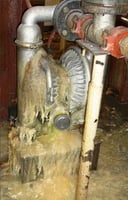At Professional Pump, we understand the critical role reliable equipment plays in keeping your...
How Mechanical Seals Fail: Causes and Solutions
 Mechanical seals play a critical role in preventing leakage and maintaining the integrity of fluid processing equipment. However, despite their importance, mechanical seals can experience failure due to various factors, leading to costly downtime and repairs.
Mechanical seals play a critical role in preventing leakage and maintaining the integrity of fluid processing equipment. However, despite their importance, mechanical seals can experience failure due to various factors, leading to costly downtime and repairs.
In this article, we'll dive into the common causes of mechanical seal failure and explore practical solutions to mitigate these issues. We want to help keep your process up and running smoothly!
Understanding Mechanical Seal Failure: Mechanical seals are designed to create a barrier between the rotating and stationary components of pumps, mixers, and other equipment handling fluids. They consist of several components, including stationary and rotating seal faces, secondary seals, and springs, which work together to maintain a tight seal and prevent fluid leakage.
Mechanical seal failure can occur due to a range of factors, including:
- Abrasive Wear: Abrasive particles in the fluid can cause wear on the seal faces over time, leading to reduced sealing effectiveness.
- Fretting and Corrosion: Fretting corrosion, caused by small oscillatory movements between seal components, can degrade surface finishes and compromise sealing performance.
- Improper Installation: Incorrect installation procedures, such as misalignment or insufficient lubrication, can lead to premature seal failure.
- Operating Conditions: Extreme temperatures, pressure fluctuations, and aggressive chemical environments can accelerate wear and degrade seal materials.
- Cavitation and Vibration: Cavitation-induced pressure fluctuations and excessive vibration can damage seal faces and compromise sealing integrity.
Preventive Measures and Solutions:
-
Proper Material Selection: Choose seal materials that are compatible with the fluid being handled and resistant to wear, corrosion, and chemical attack. Consider factors such as temperature, pressure, and fluid properties when selecting seal materials.
-
Optimized Seal Design: Ensure that the mechanical seal design is suitable for the application and operating conditions. Consider factors such as seal face geometry, spring tension, and secondary sealing elements to maximize sealing effectiveness and longevity.
-
Regular Maintenance and Inspection: Implement a proactive maintenance program to monitor seal condition and performance regularly. Conduct visual inspections, leakage tests, and surface roughness measurements to detect early signs of wear or damage.
-
Proper Installation and Alignment: Follow manufacturer recommendations and industry best practices for mechanical seal installation, ensuring proper alignment, lubrication, and torque settings. Train personnel on proper installation techniques to minimize the risk of premature failure.
-
Fluid Condition Monitoring: Monitor fluid quality and condition regularly to identify potential sources of contamination, abrasion, or chemical attack. Implement filtration systems, fluid analysis programs, and condition monitoring techniques to maintain fluid cleanliness and integrity.
-
Address Operating Conditions: Take steps to mitigate extreme operating conditions that can accelerate seal wear and degradation. Install pressure relief valves, temperature control systems, and vibration dampeners to minimize stress on the mechanical seal.
Mechanical seal failure can be a costly and disruptive issue in fluid processing equipment, but with a proactive approach to maintenance, material selection, and operating condition management, many common failure modes can be mitigated or prevented altogether. By understanding the causes of mechanical seal failure and implementing preventive measures and solutions, operators can maximize equipment reliability, minimize downtime, and extend the lifespan of mechanical seals.
By implementing these preventive measures and solutions, operators can minimize the risk of mechanical seal failure and ensure the reliable and efficient operation of fluid processing equipment. With proper material selection, optimized seal design, regular maintenance, and attention to operating conditions, mechanical seals can continue to provide effective sealing performance and prevent costly leaks and downtime.





Add a Comment